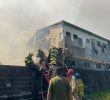Verifiability of transmitted results, discrepancy in figures
There was also no way of telling whether the copy sent electronically by City Board of Canvassers (CBOC) were the same as the Certificate of Canvass (COC) they printed and released. An hour after CBOC chair Danilo Cullo declared the canvassing adjourned at 5 pm, four days after the elections, CCS laptop operator Arnel Rodriguez was still checking with someone on his phone whether they were able to send 100 hundred percent of the results of voting in the city.
Rodriguez was asking because the CCS laptop was unable to print another copy of the completely canvassed results. The only copy they were able to print was the partial canvass report as of May 12. A CCS laptop prints only once. It prints out just the figures reached at a certain stage of the tabulation.
The CBOC temporarily suspended the counting when the canvassing process was at 99.40 percent, pending the arrival of results from clustered precincts whose attempts at electronic transmissions failed. This prompted lawyers of political parties to compel the operator to execute the “irreversible” command that allows the CCS laptop to print results. The lawyers wanted to make sure that there would be a back-up in case the CCS laptop bogs down when canvassing resumes the next day. Due to the premature printing of results, the Davao board of canvassers was able to release the 99.4 percent canvass report printed May 12. But a look at the results, however, showed some discrepancies when compared with the list released on May 12. Figures of partylist votes were changed. Akbayan partylist posted a vote of 21, 431 as of closing time on May 12. But on May 13, Akbayan already garnered a total number of 21,471 votes, or an increase of 40 votes. Bayan Muna got an increase of 35 votes from its last count of 33, 341.
Anxious for the country’s first automated voting, teachers serving as Board of Elections Inspectors (BEI) at the Cesario Villa Abrille Elementary School in Barangay Bucana pray for “spiritual guidance.” (davaotoday.com photo by Cheryll Fiel)
Senatorial candidate Jinggoy Estrada, for instance, recorded a disparity of
1, 363 votes from the 365, 362 posted on the May 12 to 366,725 reflected on
May 13 COCs.
But the figures for the mayor, vice-mayor, the councilors including the congressional in each of the three districts, however, remained the same. The discrepancy of figures casts doubts on the accuracy of computerized canvassing.
Problems at the voting precincts
The Commission on Elections’ (Comelec) new clustering scheme was blamed for the delay in the voting process. The delay disenfranchised voters. Only 577,602 of the city’s 943,309 registered voters cast their votes on May 10. This means 365,707 or 39 percent of registered Davaoeño voters unable to vote. The voting was hardly kept secret. Armchairs where voters sat to shade their ballots were placed very close to each other that it was almost impossible not to see what the other side has put on his ballot. There was no sufficient mechanism to verify whether the Precinct Count Optical Scanner or PCOS machines interpreted the ballots correctly, much less ensure that counting was correctly done.










